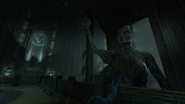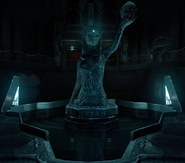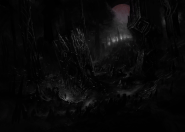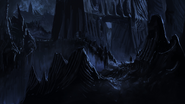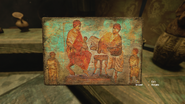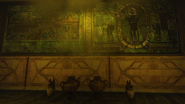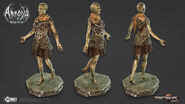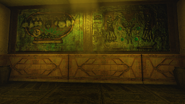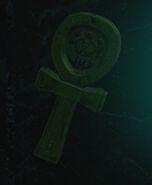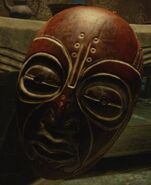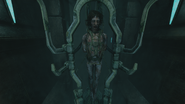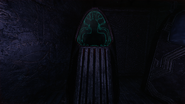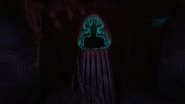

- This article is about fictional world referred to in the Amnesia series. For the level from Amnesia: Rebirth, see The Dark World.
“The faint glow escaped my fingers and began to spark brightly and spirit me away. Unlocking alien memories of spiralling towers, endless deserts, and impossible geometry.
”Daniel’s diary, detailing his vision of the Other World
The Other World (also known as Zerzura, Eden, or The Dark World) was the homeworld of Empress Tihana and Alexander of Brennenburg.[1] By most, it was known simply as the "Other World."
Though mentioned many times in the first two games of the Amnesia series, Amnesia: The Dark Descent and Amnesia: A Machine for Pigs, as well as in the Dark Descent's DLC, Amnesia: Justine, the Other World is not seen nor visited until the third game Amnesia: Rebirth. It is also heavily mentioned in Amnesia: The Bunker.
History[]
Ancient History[]
Almost nothing is known about the Other World's ancient history, apart from the names of the six prior empresses before Tihana and a vague mention of "The True Ancestors".
The Reign of Atua and the Birth of Tihana[]
At some point in time, Empress Atua inherited the throne from her parent, Marai Stone-Heart. It is unknown when exactly Atua's only daughter, Tihana, was born, only that Tihana was on the throne by the 4th Century AD, although it very possible that Tihana was born and inherited the throne much earlier than that.[2] Which means that Tihana was at least 1,500 years old in 1937. It appears is that she and her mother were born with a degenerative illness, one that degraded bones and sinew over time.[3]
The Revival and Accession of Tihana[]
At some point, seemingly when Tihana had reached maturity, the affliction began killing her slowly. Atua instructed the alchemists to do whatever was necessary to keep her daughter alive, decreeing that she must survive to continue the dynasty.[3] Temaku and other alchemists followed Atua's orders and "fought to keep the life in her."[3] This medical effort is only fragmentarily described, but it included surgical procedures on Tihana, namely some kind of "spinal repair" and eventually the injection of Vitae's somatically restorative properties to allow her to live in spite of her condition.[4][3] It is also implied that Empress Atua donated some sort of vital organ to her daughter, as she died immediately after they stabilized Tihana's illness.[3]
After her mother’s death, Tihana "took up the orb from her lifeless brow" and succeeded her as empress, becoming the seventh ruler of her dynasty.[3][5] During her coronation, she walked out of her tower at the head of a procession, bare-headed and bare-handed, dressed only in a simple robe.[6] She walked among her subjects as they cried out her name "'Tihana, Blessed Tihana,'" with many weeping openly, crowding the streets and alleys of the city to view their new sovereign; furthermore, Temaku and the other alchemists followed the new empress, carrying a litter bearing seven orbs.[6]
Some time after her coronation, it is claimed that she desired to marry in order to have a child, but decided that none of the princely candidates measured up.[7] However, this is information from a fairy tale inspired by the actual events, and so was likely written centuries later with information passed down through those centuries, which makes it rather unreliable.[7] However, it is recorded that Tihana underwent various medical studies and fertility treatments, both to investigate her now-stabilized affliction and in an attempt to help her have a child.[4][8]
Fertility Struggle[]
Temaku's subordinate alchemist Atharu tested samples from Tihana and from the deceased Atua, thereby establishing that both had the same disease, though Atharu noted it "did not manifest in the forebears" —possibly meaning that the disease was not present in the bloodline up till Atua, or that it was present but asymptomatically in the royal ancestors.[8] Atharu discovered that while they had stabilized Tihana's disease through the use of vitae, it was only able to repair and halt the affliction for a time, as if it was discontinued the affliction would bounce back with a vigour, requiring consistent doses to keep the Empress alive. Temaku then ordered Atharu to conduct further examinations of the effects of different dosages, different areas of injection, and timing, but what came of these later investigations is not known.[8]
Atharu was also directed to examine the changes in the Empress's disease from before the treatment and after to see how it affected her fertility.[4] She discovered that despite Tihana's illness, her reproductive organs were still working until the "spinal repair."[4][8] However, in spite of the incredible properties of vitae in mending tissues, the reproductive organs withered away rather than reconstruct.[4] This confused Atharu, who wondered whether or not the illness had permanently affected the reproductive organs.[4][8] She asked Temaku if she should send up a report to the Empress, but he replied that it would be "unnecessary," which Atharu agreed with, calling the fertility investigation a trivial matter only of "alchemical interest" due to Tihana's immortality.[4]
However, Tihana's thoughts on the matter differed greatly from those of her alchemists, as she desired above all else to have a child, not for politics or for securing a future with an heir, but for herself.[9] However, since the disease was stabilized and now that she had "forever," Tihana contemplated ending the sessions of fertility treatments, which had a long shot of success, and instead focusing on ruling the empire and providing for her people.[9] Which it appears she eventually did, turning all her attention to the empire.
The Resplendent Reign of Tihana[]
It appears that Tihana's rule was largely prosperous, with her regime overseeing numerous inventions and innovations that helped increase the power of the empire as well as greatly increase living standards for the citizenry as well.[10] As head of government in addition to being head of state, with her having the final say when it came to major decisions for her empire, which she sent out to a council to implement.[10] Very little is known about her day-to day-rule, but there appears to have been some political strife with Septarch Ilyander and the Enkindled Fortress, who dispatched messengers to the Outer Isles despite a previous warning, this led to some kind of military expedition as a show of force, the outcome of which is unknown.[10]
One of the most important advancements was the industrialization of Vitae production.[11] Tihana's regime allowed Ayandra the Apostate, a political exile from the Enkindled Fortress, asylum in her realm.[12] Ayandra proved his worth by proposing a decoction of the amnesiac [[Amnesia potion}|Elixir of Emmerysh]] be administered to the subjects of Vitae extraction, which proved to be a breakthrough since the "stock" now experienced less fatigue during torture sessions, allowing more Vitae to be extracted than normal.[12] This triumph impressed Temaku, who took Ayandra under his wing until the latter was discovered to have committed previous crimes, which led to Tihana's regime banishing the Apostate beyond return.[12]
Temaku and his alchemists worked on further improving the process, at first creating torture pods that tortured victims but fed them the amnesia potion to refresh them. After the elixir breakthrough, Suvar and Atharu worked on revising the memory-view capsules to provide someone's happiest memories and thus lead to a greater response to the pain, one that would provide more extractable Vitae.[13][14][11] Soon Atharu and the alchemists had yet another breakthrough in the process, with a cycle of pain, amnesia, and hope instituted to maximize the response to the torture and thus the Vitae yield.[12][11][10]
However, the public opinion of the process was apparently unpopular enough to be a political problem, which led Temaku to instruct Atharu and the others to reduce the cycle of pain, although it is possible Tihana herself ordered Temaku to do this.[14] In any case, these innovations greatly expanded the empire's power. It appears that Tihana's constant use of Vitae for centuries had a side affect of requiring greater and greater quantities of it to both keep her alive and also to fuel her powers, which eventually required a gargantuan supply.[15] It seems that her physical body was eventually rendered immobile, becoming almost plant-like, but Tihana was able to project her form into the world, where she appeared as a ghostly blue specter; however, she was unable to physically interact with the world in this state.
Tihana, Who is Eternal, yet Mother to Nothing at All[]
Despite the attempts to sanitize the process for public opinion, the mass extraction of Vitae caused unrest among Tihana's people, and the discontent was such that it eventually spread to the ranks of her alchemists, two such examples are Kita and Taina. A group of rebels under Kita's leadership conspired to kill Tihana and end the industrialized torture factories, via the injection of the Shadow's red flesh into the extraction system.[16][17][18][19] Although they managed to infest a quarter of the system with this substance and cause the collapse of the Great Gate, they ultimately failed to kill her.[16][19] These acts of rebellion unintentionally caused their world to face utter destruction, destroying their civilization, killing nearly every citizen, and turning most of the alchemists into floating wraiths of nightmare.[16] Even after this cataclysmic sabotage, Tihana managed to survive with only one of her four Vitae pipelines destroyed, now presiding over a dead civilization.
It is unknown when exactly the destruction occurred, only that it happened between the 4th Century and May 1839.[2][20] Due to the ancient nature of the structures they built as well as the human cults that worshipped them, as well as the fact that human stories about the Otherworlders have long degraded to mythological stories, it is likely that the destruction happened much closer to the 4th Century than the 19th.<[2][20]
During The Dark Descent[]
From Prof. Herbert's notes in Amnesia: Rebirth, it can be safely inferred that the Other World was already destroyed by 1839 CE, the year Amnesia: The Dark Descent was set (Earth reckoning).[21][22] [23][24] This is corroborated by the fact that human artifacts found in Other World torture/research facility are mostly from antiquity, with no more recent objects present.
During The Bunker[]
During Henri Clément's venture to escape the Bunker, he discovered that the detonation plunger needed to blast the collapsed exit of the bunker is inside of the Roman Tunnels. When these tunnels are entered, it is evident that this was an area where the boundaries between Earth and the Other World was weak.
Once the exit of the Bunker is detonated, the actual exit is not cleared, but instead a tunnel that goes straight down into an outpost of the Other World is revealed. This section appears as many pillars with walkways connecting them, with some of the walkways being made of collapsible wood. Once Henri enters this area, the Beast does as well, still pursuing Henri.
This is the final area of the game that Henri must escape, and he can do so with or without defeating the Beast, which is done by destroying a wooden walkway just as the monster walks on it, sending it into the unseen depths below. Once Henri escapes this area, the game's ending occurs.
During Rebirth[]
A considerable amount of buildings remain standing (either intact or partly collapsed) but, other than two Other Worldly individuals, the only known living people are Ghouls, Wraiths and the vitae extraction victims. Portals, rifts, many devices and some transportation vehicles are still operational.
Environment[]
The nature of the Other World's ecosphere and climatology before the catastrophe is not clear. However, the various alien forms of life such as slugs, the skeletons of oddly-shapped animals, and various forms of glowing and non-glowing plantlike organisms, suggests the Other World once had an ecosystem with numerous species.
Daniel may have glimpsed what the pre-destruction Other World looked like when he first discovered his Orb: the orb gave Daniel visions of "spiraling towers, endless deserts, and impossible geometry."[25] This may indicate that, prior to its destruction, some parts of the Other World's layout consisted of dry, rocky, desert-like environments.
Liquid water existed on the Other World, as seen in Amnesia: Rebirth and and while to what extent that the water cycle resembled Earth's is unknown, there was at least one large body of water. This is evidenced by the existence of the Outer Isles; furthermore, the second ruler of the Empire was called Iren Sea-star and was also called the "Spear of the Isles," it is also possible the Kaernk, an aquatic species, originated from the Other World's bodies of water.[26][5]
Inhabitants[]
The majority of the inhabitants of the Other World appear to be humanoid, distinguished by their blue skin. Some of the Other World's elite inhabitants used Vitae to extend their lives, notably the alchemists and Empress Tihana. In the wake of the Other World's collapse, it is now only inhabited by human processing victims, Ghouls and Wraiths.
Only a handful of normal humanoids can be seen in the Other World. They are Harvesters, Wraiths, or human victims in the pods or waiting to be processed. The capital city appears extensive when viewed from a vantage, so whether there was a surviving population is unknown.
Political Landscape[]
It is said that the Other World had known some political strife between its states.[10] Mention is made of a place called the Enkindled Fortress, seemingly ruled by a Septarchy.[10] Septarch Ilyander seemed to have dispatched envoys to the outer isles of the Empire under the guise of a trading mission with presumably some ulterior motive,[10] which was commented on negatively in one of the tablets and deserving of a military response in the form of additional troop deployment.[specify] Further on, it is mentioned how the breakthroughs regarding Vitae could be used for defense,[10] hinting that the political situation of the Other World was not entirely peaceful. Ayandra was also a citizen of the Fortress, (and presumably would adopt the identity of Alexander of Brennenburg) but was banished for "apostasy" and came to the Empire to seek asylum,[12] further lending credence to the assumption that the Enkindled Fortress was, at the very least, not on polite terms with the Empire. Additionally, there is also a mention of regiments made up of military units called "fists" though the exact details and size thereof are not elaborated on but three fists were thought sufficient to dissuade the Enkindled Fortress from meddling in the Outer Isles.[10]
When picked up, data tablets appear consecutively appear in several languages, including English. This maybe an indication for several languages were being spoken in the Other World and these people could understand some human languages. Or at least, people in The Empire understood it. They had bases in our world, as a result, they can be expected that they were able understand other human languages than English (i.e. Latin and Arabic/Berber).
Tihana's Empire[]
- Main article: The Empire
While the Other World seems to have been composed of more than one independent or semi-independent political states, such as the Enkindled Fortress, one of the most powerful of these was Empress Tihana's state, simply referred to as "the Empire." The Empire was at one point a vast, highly advanced civilization.
Government[]
The government of the Empire appeared to be that of a hereditary monarchy, as subjects to a single monarch, of which there had been seven.[5] The last Empress, Tihana, became effectively immortal as a result of Vitae, which she consumed initially to cure her illness. Later on the Empress and her alchemists sought to alter the quality of life for both the monarch and the populace, creating the Ghouls to gather human life-stock to provide this energy supply. City-spanning, monumental torture machines ensured an infinite flow of the substance, rendering the Empress' lifespan indefinite, as well as any surviving subjects who managed to hook themselves into the Vitae supply network.
Culture[]
Magic and alchemy were commonplace in the Empire, and possibly other countries as well. The Orbs were understood well enough that the civilization harnessed their power, until Kita's assasination plan destroyed this civilization. While memory jars throughout the ruins do not mention the exact environment, the Other World is now a blasted wasteland with a greenish lambent sun, with nearly all of its inhabitants deceased or transformed into Wraiths. Only a small handful of the dominant population survived, along with a species of vine and small, slug-like creatures. While the direct cause of this is unknown, the alchemist, Kita, believes that his experiments with the Orbs were responsible. This catastrophe also caused the Shadow to appear, which they called "The Flesh" in reference to the red pulsating flesh that it spreads.
Some artwork were found on the walls and tables of the Factory. They resemble the Ancient Egyptian and Greece style. These artwork depict Vitae extraction and some people paying tribute to Empress Tihana. From this knowledge, it can be assumed that Otherworldly people have developed appreciation for and expertise of paintings and decorations.
Humans, being used for Vitae production, were treated like cattle, which led to some Otherworlders to look down on humans.[27]
Technology[]
At least one of the Other World's civilizations was by all means a highly advanced culture, utilising both technology and magic to achieve a level of development that surpasses most, if not all of Humanity's achievements by the time Amnesia: Rebirth takes place. Machinery showed a great variety of size and sophistication, ranging from near-megalithic size all the way down to devices that would be transported by hand.
The structures were of a cyclopean build, using what appears to be reinforced stone or concrete along with metal and glass, with some that rival skyscrapers in height and were equipped with advanced technology such as button-operated doors, wireless energy nodes, teleportation devices and other techno-magical wonders. Esoteric technologies such as Memory Capsules and Data Tablet were used regularly by the academic and elite levels of the society.
It is not known what forms of transportation were used, but the Traveler's Locket and teleporters seem to suggest that teleportation was used for personal transport and some bulk cargo (such as human subjects being transported from Earth to the Other World). More mundane modes of transport certainly existed within the capital of the Empire, such as elevators and aerial lifts.
They had at least a few designated portals between Earth and the Other World to travel back and forth. Location of one of these in our Earth is known: the portal near Tomb of Tin Hinan, under the Algerian Desert. It was visited by Tasi in Amnesia: Rebirth and was being studied by Prof. Herbert's team (including Daniel) before the events in Amnesia: The Dark Descent. It is unknown if Alexander used this portal after being exiled to Earth. He might have used another portal In Europe (if there were any functional ones). Khaled stated that there were several of these gates.[28] So, Alexander might have used any of these gates to come to Earth. Besides the portals, Otherworldly people seem to utilise rifts to travel between the worlds. There are several of them in Algerian Desert and it is unknown if there are any rifts in other parts of Earth.
Role of Vitae[]
The industry and science of the Empire, and possibly the Other World in general, appeared to orbit around the use and extraction of Vitae. While the capture and torture of humans to obtain it was considered a necessity rather than something enjoyable, inflicting pain and torture became commonplace and was studied and implemented thoroughly.[29][14]
The production of Vitae appeared to serve a multitude of functions in the civilization's daily life, rather than just life extension, as it was demanded by the "populace".[15] Some humans were transformed into Harvesters, also referred to in North African and Middle Eastern cultures as "Ghouls,"[30][31] in order to capture humans for Vitae processing. Complex machines collected Vitae from victims, who are graded for their "purity" to determine how much can be extracted. There were at least six functional factories to supply the vitae demand.[15] The Vitae was collected in leyden jars which serve multiple functions in powering machinery.
The Empire had fallen due to a great cataclysm. Said cataclysm was caused by Kita and his group who opposed the cruel nature of their power source. They sabotaged the The Great Gate and tried to corrupt the Vitae factories with the Shadow's residue.[16] Their plan was to poison the Empress with the corrupted Vitae.[16] Instead, they only unleashed the Shadow's fury, killing virtually everyone but the Empress and Kita. At minimum, the denizens of the Empire's capital had been annihilated by the Shadow's wrath, with the only known survivors being Empress Tihana and Kita, who were hooked up to Vitae supplies to survive.
Time Keeping[]
In the scientific data tablets found in Amnesia: Rebirth, it is indicated that Otherworldy citizens referred to a day as "rise" and to either weeks or parts of a day as "calling." There are also signs of certain things: "Bahna," "Idu," "Olann," "Auranga," "the Seven," etc. These may signify months and be named after people, places, or perhaps celestial bodies.[29][14][4][8]
The Otherworlders used a time measurement unit called "idar".[29] It is not clear what the rough equivalent of the idar in Earth's time units. But since it was used in the hunting grounds as Harvesters hunted human victims, as well as when developing the automated Vitae extraction process with the amnesia-causing Elixir of Emmerysh and the memory capsules, it is likely a single idar is somewhere within the range of seconds and a minute.[29][14]
Notes[]
- A Memory Capsule by Alexander reveals that he was banished by his brethren to Earth for unknown reasons. He mentions that his brethren "lust for power without restraints", while he himself "craves for a fair judgement and safe return."[32] Such banishment was possible thanks to a Traveler's Locket.
- The Tesla enemy is constantly blinking in and out of existence, being teleported to "the Other World" and back, though it is unknown if this is Alexander's world or a completely different one.
Trivia[]
- The Other World's depiction might have been inspired by some of H.P. Lovecraft's fictional works.[expound]
- It is possible that if Daniel were to choose the Agrippa ending, he would wake up in this world, as Agrippa's severed head was thrown into the portal Alexander was trying to open. Daniel does not physically see this world, but he hears Agrippa assuring him that it would be all right.
- Two of the concept pictures for the Orb Chamber seem to depict a glimpse of the Other World — one depicts a plain orange sky while the other seems to show a tall cliff with floating rocks, two suns, and a large moon about to eclipse one of them.
- According to one of the cut notes from Amnesia: Rebirth, local people of village near Al-Mamaru Fort unwittingly compared Other World to the biblical city of Sodom.[33]
- Although there are no open rifts or portals are seen/mentioned in Amnesia: The Bunker, Otherworldly people have a harvester nest and a fountain right next to the Bunker and Roman Tunnels. So, it is unknown how they managed to travel to this location and construct these structures. This was likely possible due to an unseen rift/portal just outside of Bunker and Tunnels.
Gallery[]
References[]
- ↑ 1.0 1.1 1.2 Explorer's Note (3) (Rebirth)
- ↑ 2.0 2.1 2.2 Daniel's Diary: 17th of May 1839, first entry (TDD)
- ↑ 3.0 3.1 3.2 3.3 3.4 3.5 Cylinder: Accession (Rebirth)
- ↑ 4.0 4.1 4.2 4.3 4.4 4.5 4.6 4.7 Fertility Investigation (Rebirth)
- ↑ 5.0 5.1 5.2 Bloodline List (Rebirth)
- ↑ 6.0 6.1 Cylinder: The Coronation (Rebirth)
- ↑ 7.0 7.1 Book Fragment (Rebirth)
- ↑ 8.0 8.1 8.2 8.3 8.4 8.5 Medical Investigation (Rebirth)
- ↑ 9.0 9.1 Cylinder: Patient's Thoughts (Rebirth)
- ↑ 10.0 10.1 10.2 10.3 10.4 10.5 10.6 10.7 10.8 Political Letter (Rebirth)
- ↑ 11.0 11.1 11.2 Cylinder: Breakthrough (Rebirth)
- ↑ 12.0 12.1 12.2 12.3 12.4 Note on the Apostate (Rebirth)
- ↑ Note on Memory Process- Cycle of Replenishing (Rebirth)
- ↑ 14.0 14.1 14.2 14.3 14.4 Note on Memory Process- Public Opinion (Rebirth)
- ↑ 15.0 15.1 15.2 Note on Vitae Flow (Rebirth)
- ↑ 16.0 16.1 16.2 16.3 16.4 Cylinder: The Fall (Rebirth)
- ↑ Cylinder: The Flesh (Rebirth)
- ↑ Cylinder: The Formula (Rebirth)
- ↑ 19.0 19.1 Cylinder: Last Hope (Rebirth)
- ↑ 20.0 20.1 Herbert’s Final Note (Rebirth)
- ↑ Explorer's Note (1) (Rebirth)
- ↑ Explorer's Note (2) (Rebirth)
- ↑ Explorer's Note (4) (Rebirth)
- ↑ Tin Hinan Note (1) (Rebirth)
- ↑ Daniel's Diary – Algeria (3/3) (Rebirth)
- ↑ Agrippa Channels Weyer (TDD): "Tampter on the other hand will prove more difficult. I don't think it exists in this world. Simply writing the word with these letters looks wrong. I believe it's a property of the secretion in the water dwelling Kaernk."
- ↑ Memory Capsule – Study (TDD): "From where I came, mankind is not even wasted a breath [...]"
- ↑ Note to Professor (Rebirth)
- ↑ 29.0 29.1 29.2 29.3 Hunting Note (Rebirth)
- ↑ Ghul Text (Rebirth)
- ↑ Note from Tasi (Rebirth)
- ↑ Memory Capsule - Laboratory
- ↑ Note on Artifacts (Rebirth)
[]
| Locations in The Dark Descent & Justine | |||||||||||
|---|---|---|---|---|---|---|---|---|---|---|---|
| |||||||||||
| Locations in Amnesia: Rebirth | |||||||||||
|---|---|---|---|---|---|---|---|---|---|---|---|
| |||||||||||
| |||||||||||
| |||||||||||
| |||||||||||
|

